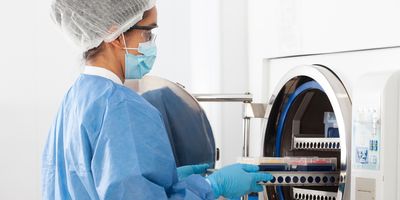Safer Sterilization: Improvements in Autoclave Safety
Advances in autoclave technology help mitigate the hazards of high temperatures and pressures
The autoclave, an invaluable sterilization and safety tool, can be found in many labs and healthcare facilities. Ranging in size from small, benchtop machines to larger walk-in systems, there is an appropriate autoclave to match the needs of any industry. Despite this variability and utility, autoclaves can present a significant danger to the lab environment due to the high temperatures and pressures involved in their function.
Fortunately, we have come a long way since the invention of the autoclave in 1879, with most advancements revolving around safety features that help keep researchers and lab technicians safe.
Autoclave hazards and safety features
While autoclaves are vital equipment for most labs, they represent a substantial risk due to the inherent high temperatures and pressures. A lack of instituted safety protocols, poorly maintained autoclaves, or older autoclaves lacking modern safety features can result in serious harm such as scalding, trauma injury, the spread of infectious diseases, and damage to surrounding lab equipment and infrastructure.
Effective steam sterilization requires four elements: pressure, temperature, steam, and time. Pressure, at a minimum of 15 psi, is used to raise the boiling temperature of water, resulting in superheated steam ideal for sterilization. This steam typically reaches temperatures of 250°F (121°C) or 270°F (132°C) and must be maintained long enough—based on the item and autoclave—to kill microorganisms.
As with all pressurized containers, autoclaves can be dangerous if improperly handled. While rare, explosive opening of the door, due to seal malfunctions or premature opening, can cause structural damage, serious trauma injury, or even death. The first line of defense is an electronic door-locking system that prevents the sterilization cycle from starting if the door is not properly secured. Additionally, some autoclaves are equipped with an emergency stop feature that allows operators to terminate the sterilization process immediately if a critical failure is detected, providing additional control and protection. Newer autoclaves may also have safety interlocks that sense temperature and pressure, preventing users from opening the autoclave before the temperature and pressure have dropped to a safe level. Most importantly, autoclaves should be equipped with safety valves or pressure relief valves designed to release steam pressure if the internal temperatures exceed safe operating limits, acting as a critical fail-safe should all electronic controls fail.
To further enhance safety, modern autoclaves incorporate over-temperature protection to prevent overheating, over-pressure protection to manage excess steam pressure, and over-current protection against electrical malfunctions that could lead to equipment failure or fire hazards.
More commonly, autoclave injuries are a result of high temperatures and steam. While most autoclaves are well insulated to prevent heat from radiating out of the chamber, scalding can easily occur when the user loads or unloads the machine. This risk can be lessened by using an autoclave with automatic door opening and closing, as this keeps the operator away from escaping steam. Additionally, some models have a steam condensing mechanism, which condenses superheated steam into a small amount of water post-sterilization, or a cooling cycle that decreases the temperature inside the autoclave, making the removal of items safer.
A third, less obvious risk is the potential spread of infectious particles due to incomplete sterilization. This is where automation, sensors, and remote monitoring excel. Modern autoclaves employ intuitive user interfaces and programmable cycles, tailored to specific sterilization needs, to ensure the correct application of time and heat, minimizing opportunities for human error. Embedded sensors actively monitor the entire process and can trigger alerts or shutdowns for immediate corrective action at any sign of deviation. Complementing this, remote monitoring enables lab personnel to remotely track sterilization progress, offering real-time insights on temperature and pressure levels, enhancing both safety and efficiency. To further bolster the efficacy of sterilization, some autoclaves include a post-sterilization drying cycle, which can help minimize the risk of microbial growth during subsequent storage and handling.
While no amount of safety features can make up for a rigorously trained and designed safety protocol, modern autoclaves are better equipped to reduce the potential for harm caused by human oversight or error in their operation. Investing in these safety features and maintaining your autoclave will help ensure a safe laboratory environment.


